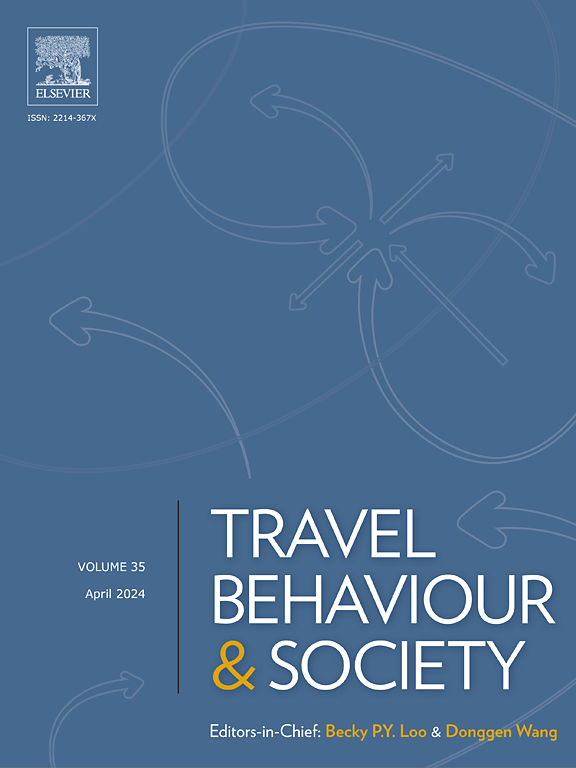行人安全感知的性别差异:物理和数字领域
IF 5.7
2区 工程技术
Q1 TRANSPORTATION
引用次数: 0
摘要
公共空间在城市生活中发挥着至关重要的作用,但安全观念影响着城市的流动性、可达性和宜居性。尽管之前的研究已经解决了影响感知安全性的环境因素,但数字技术在智能城市中的作用,如监控系统、智能手机和安全应用,仍未得到充分探索。随着城市采用智能安全工具,需要进一步的研究来了解它们对安全观念上的性别差距的影响,特别是通过研究女性的恐惧如何形成这些差距。本研究采用两阶段方法。首先,分析了来自48个国家的数据,以评估夜间独自行走的行人的恐惧程度,并使用可持续发展目标参数16.1.4检查安全认知方面的性别差异。随后,对以色列三个大都市核心城市的754名参与者进行了全面调查,评估了性别在安全观念和流动性方面的差异。该调查调查了物理(如照明、街道活动)和数字(如智能手机应用程序、监控)领域影响安全的因素。研究结果显示,女性的恐惧强烈地影响着夜间的活动。女性从活跃的街道环境中获得更多安全感,并越来越依赖智能手机来管理恐惧。该研究强调需要一种混合方法,将城市设计、数字安全工具和社区参与结合起来。研究结果有助于更广泛地讨论交通、城市规划和性别敏感的安全政策,强调将环境设计与新兴的智慧城市技术相结合以促进包容性公共空间的重要性。本文章由计算机程序翻译,如有差异,请以英文原文为准。
Gender differences in pedestrian safety perceptions: the physical and digital spheres
Public spaces play a crucial role in urban life, yet safety perceptions influence mobility, accessibility and urban liveability. Although prior studies have addressed environmental factors shaping perceived safety, the role of digital technologies in smart cities, such as surveillance systems, smartphones and safety applications, remains underexplored. As cities adopt smart safety tools, further research is needed to understand their effects on gendered gaps in perceptions of safety, particularly by examining how women’s fear shapes these disparities.
This study employed a two-stage approach. First, data from 48 countries were analysed to assess fear levels among pedestrians walking alone at night and examine gender disparities in safety perceptions using Sustainable Development Goal Parameter 16.1.4. Subsequently, a comprehensive survey of 754 participants in core cities of three Israeli metropolitan areas assessed gender differences in safety perceptions and mobility. The survey examined factors shaping safety in both the physical (e.g. lighting, street activity) and digital (e.g. smartphone apps, surveillance) spheres.
Findings show that women’s fear strongly influences nighttime mobility. Women draw more security from active street environments and increasingly depend on smartphones to manage fear. The study underscores the need for a hybrid approach that integrates urban design, digital safety tools and community engagement. The findings contribute to the broader discourse on mobility, urban planning and gender-sensitive safety policies, emphasising the importance of integrating environmental design with emerging smart city technologies to foster inclusive public spaces.
求助全文
通过发布文献求助,成功后即可免费获取论文全文。
去求助
来源期刊

Travel Behaviour and Society
TRANSPORTATION-
CiteScore
9.80
自引率
7.70%
发文量
109
期刊介绍:
Travel Behaviour and Society is an interdisciplinary journal publishing high-quality original papers which report leading edge research in theories, methodologies and applications concerning transportation issues and challenges which involve the social and spatial dimensions. In particular, it provides a discussion forum for major research in travel behaviour, transportation infrastructure, transportation and environmental issues, mobility and social sustainability, transportation geographic information systems (TGIS), transportation and quality of life, transportation data collection and analysis, etc.
 求助内容:
求助内容: 应助结果提醒方式:
应助结果提醒方式:


